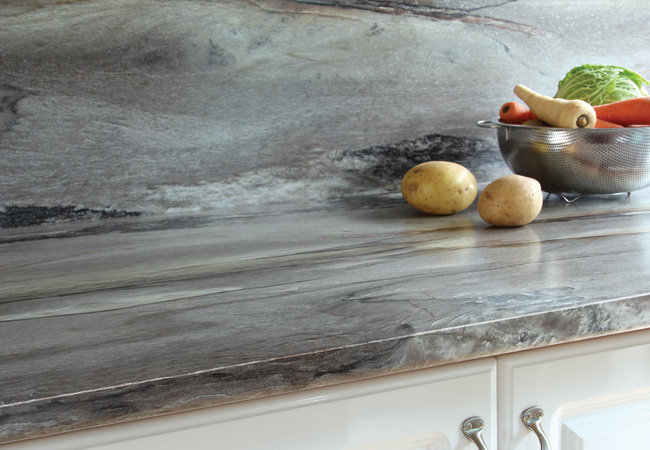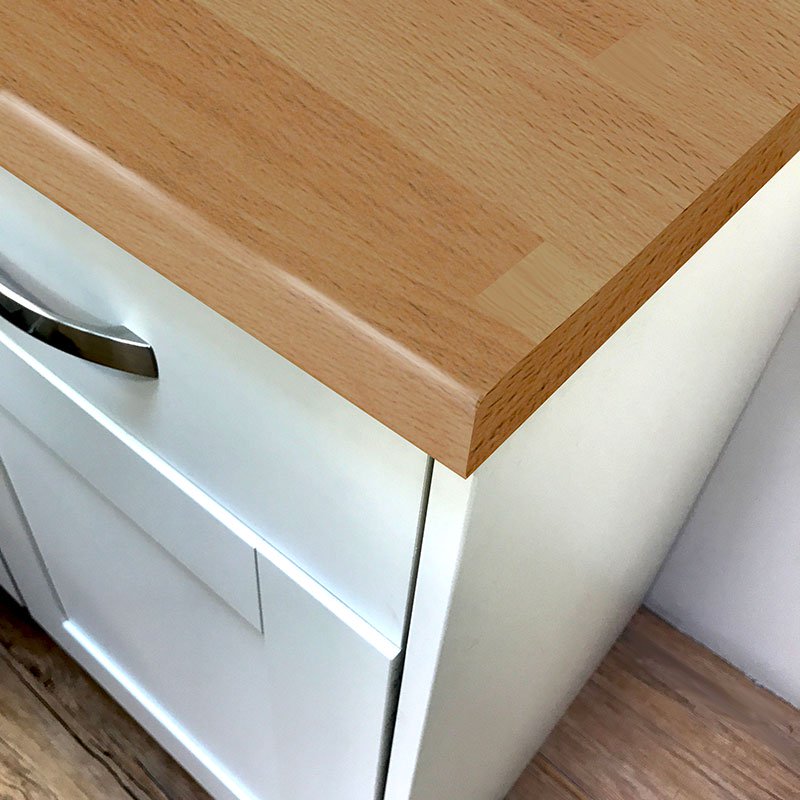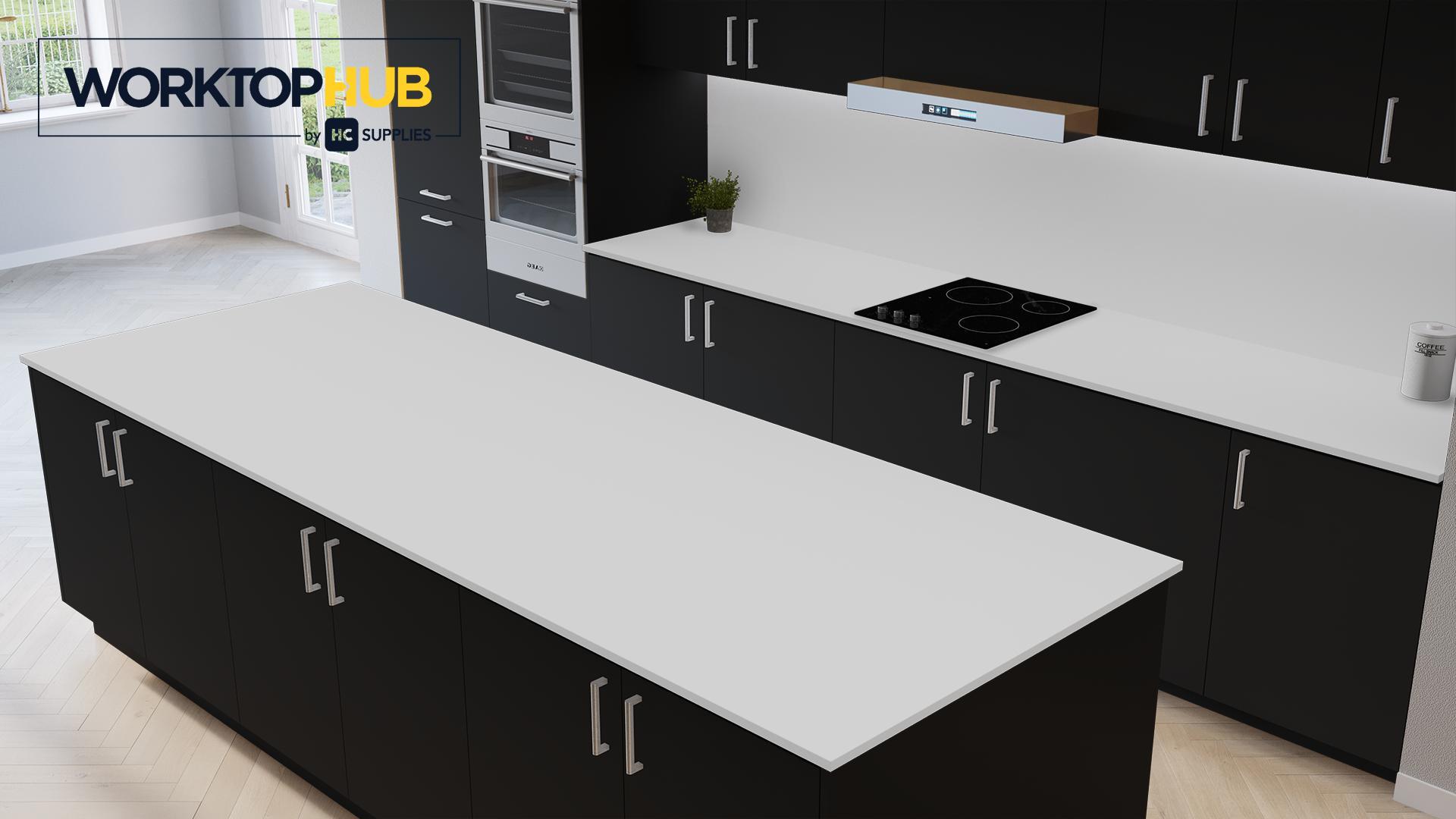Laminate worktops are an extremely popular choice with many homeowners. They’re the lowest cost worktop material, they’re durable and they’re available in a wide range of colours, styles and textures. There’s no wonder so many people choose to install them in their kitchens.
However, a newer type of laminate worktop, compact laminate worktops, have also risen in popularity. Knowing the differences between the two and how they compare can help you to choose the right worktop for your home.
In this guide, we’ll take a look at laminate worktops, their pros and cons, and we’ll also explore how compact laminate worktops differ.
What are laminate worktops and what are they made from?
Laminate kitchen worktops are made up of sheets of kraft paper which are mixed with resin to create a stiff, brittle sheet (a laminate sheet). This sheet of laminate is then bonded to a chipboard base to create the laminate worktop that’s ready to install in your kitchen.
Traditional laminate is made up of three layers of kraft paper and a decorative surface so the laminate sheet is only 2mm thick. If you cut through a laminate worktop, you’ll see a thin sheet of laminate and a thick MDF layer underneath.
The laminate is durable but it can scratch, fade and chip over time so it’s not as long lasting as other natural materials such as granite. It’s an affordable material that’s easy to manufacture and install in your home.
The pros of laminate worktops include:
- Lowest cost worktop material
- Durable
- Available in a wide range of colours and patterns
- Closely replicates wood or natural stone worktops
The only downsides to laminate worktops is they can be more prone to heat damage or water damage than other worktop materials.
What are compact laminate worktops and what are they made from?
Compact laminate worktops (also known as solid laminate) are made in a similar way to ordinary laminate worktops but additional layers are added until the desired thickness is achieved. In contrast to laminate worktops, solid laminate worktops are completely solid and do not have a chipboard substrate in the middle.
Compact laminate worktops are water resistant and are more durable than ordinary laminate worktops which makes them a popular option for kitchens, bathrooms and outdoor uses.
Benefits of compact laminate worktops
Compact laminate worktops are a popular choice among homeowners and can provide the following benefits:
- Wide range of colours, patterns and designs available to choose from
- Can be cut to any shape or size
- Water resistant
- Extremely durable and will last for decades
- Can replicate solid surfaces such as a quartz worktop or granite worktop without the same weight or price tag
- Uses renewable materials
- Easy to clean
The solid construction of compact laminate worktops means that they are water resistant and suitable for use with an undermount sink. Due to the way they’re made, you can also have drainer grooves cut into the surface of your worktop.
What is the difference between laminate and compact laminate worktops?
There are a number of differences between traditional laminate and compact laminate worktops that it’s important to be aware of before buying your new kitchen worktop.
Water resistance
The MDF or chipboard used to create laminate worktops will absorb water if it’s left to stand or is near a sink area. This can result in the worktop bubbling and losing it’s structural integrity which will mean the worktop needs to be replaced.
A piece of compact laminate can be soaked in water and it will not start to fail for a couple of days. These worktops combine newer polymers and resins which help to create a more hard wearing material that will retain its appearance for decades.
If you need a hard wearing worktop that can be used around a sink area or in a bathroom, compact laminate is the perfect choice.
Seams
When you have more than one piece of laminate worktop installed in your kitchen, they will need to be joined together which means the seams will be visible.
On the other hand, compact laminate worktops can be joined together almost seamlessly and the front edge can be manufactured to hide all cuts and seams so that your worktop appears to be made from one piece.
Heat resistant
Laminate kitchen worktops are not heat resistant. You may be able to place a hot plate on the surface for a few minutes but hot pots and pans are likely to burn the laminate on top. Once you have marks on the laminate surface, it’s very difficult to get rid of them and you may need to replace your worktop completely.
Compact laminate worktops can resist some heat for short periods of time but it is not generally recommended that you put hot pots and pans directly on your worktop. Exposure to excessive heat can soften the adhesives within the worktop and it can start to deform and delaminate – something that is difficult to repair.
Costs
Compact laminate worktops tend to cost more than laminate worktops but their benefits and durability weigh out the extra cost. They’re also a lower cost option than solid surface worktops and can replicate the look of natural materials.
You can expect to pay, on average, between £250 to £500 for custom-cut compact laminate worktops.
Thickness
Laminate worktops are usually available in thicknesses of between 20mm-40mm. However, compact laminate worktops are thinner and available in 12mm thicknesses. If you’re looking for a more modern kitchen and a sleeker looking worktop, these are the perfect worktops to choose from.
Take a look at our range of laminate and compact laminate worktops at Worktop Hub.





